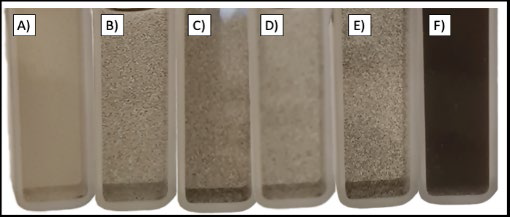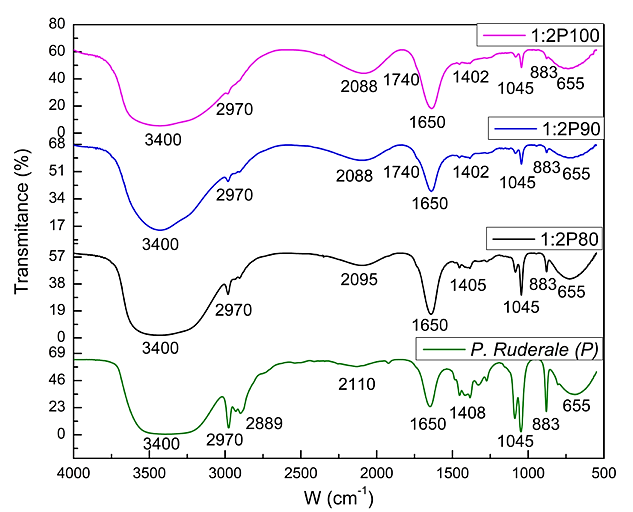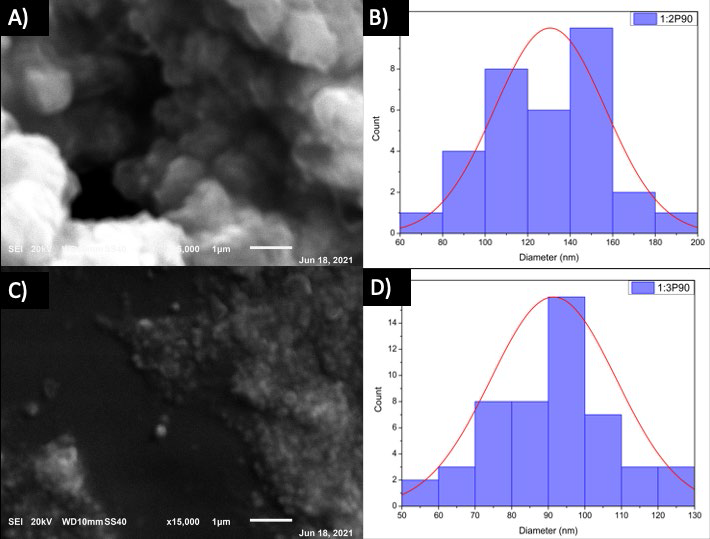1. Introduction
Nanotechnology is a multidiscipline of great importance in scientific development (Ali et al., 2020), which has allowed for the synthesis of a wide variety of noble metal nanoparticles (MNPs). These MNPs show a high surface area (Echeverry-Chica et al., 2020) that considerably increases its ratio with surface/volume (Ali et al., 2018; Kumar et al., 2020). Particularly, MNPs of noble metals as silver, copper, and gold (Gómez-Garzón, 2018) are stable in oxidation and corrosion reactions; therefore, there is a surge in recent nanomaterial research since their novel properties are related to size, shape, and structure (Gangwar et al., 2021; Gomez-Garzón, 2018). Hu et al. (2021), they presented a green synthesis of AgNPs using Rhodiola rosea rhizome extract and studied antioxidant activity, during the synthesis they observed that the color of the solution changed from green to brown-gray, which confirmed the formation of AgNPs. Similarly, they observed the peak of the SPR at 437 nm and the transmission electron microscopy (TEM) study evidenced that the AgNPs measured 10 nm approximately and were spherical (Hu et al., 2021).
It is known that AgNPs are semicrystalline structures with several properties, such as electrical conductivity, antimicrobial activity, enzymatic activity, and optical activity (Cuervo-Osorio et al., 2020; Wang & Wei, 2022). The SPR is present in the visible region of an electromagnetic spectrum (Hu et al., 2021); this phenomenon occurs when the particles are smaller than the wavelength of incident light (Hu et al., 2021; Rathnakumar et al., 2021). When AgNPs are irradiated with light, the surface electrons are excited, so their energy rises (Biswas & Mulaba-Bafubiandi, 2016), increasing the energy level of the electrons (conduction band) (Biswas & Mulaba-Bafubiandi, 2016; Höglund et al., 2021) and producing a delocalized oscillation of the electrons confined on the surface (polariton) (Biswas & Mulaba-Bafubiandi, 2016; Kumar et al., 2020) of surface plasmon. The polariton is a quasiparticle created by a photon coupled to an electric dipole (Sachan et al., 2014). In particles < 30 nm a dipole (Osorio Anaya et al., 2019) is produced and quadrupoles and/or multipoles are generated in particles > 30 nm (Pu et al., 2018). This is observed in the variation of the wavelength in the visible region, directly proportional to the size of the AgNPs (Osorio Anaya et al., 2019).
Currently, there are different methods to synthesize MNPs; they are classified as top-down, the physical method that reduces aggregation size to nanometers, and bottom-up (Abid et al., 2022), the chemical method that starts from molecular dispersion to a nanometric size. The latter is the simplest and most used. It provides control on the particle size but is costly and highly polluting, producing toxic effects in the environment (Chandra & Singh, 2018; Mirajkar et al., 2021; Upadhyay et al., 2019). On the other hand, green synthesis is no need for high pressures, high energy, and toxic chemicals, its low cost and friendly to the environment (Kumar et al., 2021; Saif et al., 2016; Santos-Espinoza et al., 2020). Plants contain metabolites and biochemical substances (Patiño-Ruiz et al., 2021) that can be stabilizing and reducing agents in MNPs synthesis (Balbuena et al., 2020). There is a large number of hydroxyl groups (-OH) in Porophyllum ruderale, which confers high stability to the radical after MNPs synthesis (Balbuena et al., 2020) since the -OH groups are in ortho position (Fukalova et al., 2022). Therefore, in the present work, a green synthesis of AgNPs using an alcoholic extract Porophyllum ruderale (P. ruderale) leaves, which contains a high phenolic compounds (Singh et al., 2020) that play a key role in particle stabilization, bio-reduction and bio-capping (Fukalova et al., 2022). They also reduce Ag+ and Ag0 ions, creating zero-valent particles that act as nucleation sites due to the presence of -OH groups (Danish et al., 2021). These AgNPs have relatively low toxicity which promising antimicrobial agent, antiviral, and biocide (Raman et al., 2021).
2. Materials and methods
2.1. Materials
Silver nitrate (AgNO3) Merck (Darmstadt, CA: 7761-88-8, Germany), Ethanol Merck (Darmstadt, CAS: 64-17-5, Germany), distilled water (Químicos Farmacéuticos Industriales SA de CV). P. ruderale was collected in Morelos, Mexico.
2.2. Porophyllum ruderale extraction
Fresh P. ruderale leaves were macerated to extract P. ruderale since they have the highest phenolic compound content. The leaves were cut, weighed (20 g), and washed with distilled water to eliminate dust impurities (Sameen et al., 2014). They were placed in a mortar for maceration, and an 80% ethanol solution was added, maintaining a solvent/leaves ratio of 2:1 (v/w). The macerated solution was placed in a 100-mL Erlenmeyer flask, which was capped with a rubber stopper, maintaining an extraction time of 36 h. The solution was then filtered and placed in vials kept at 4ºC until use (Fukalova et al., 2022).
2.3. Green synthesis of AgNPs extract of P. ruderale
The experimental design for the AgNPs was done considering two factors: synthesis temperature (80, 90, and 100 ºC), ratio (1:2 and 1:3 v/v) of [reducing agent (extract:RA)]: [precursor agent (AgNO3 0.1M:PA)]. Six samples with replicates were obtained, as shown in Table 1.
Table 1 Experimental design of AgNPs (P: extract).
| No. | SAMPLE | TEMPERATURE ºC | RA:PA |
| 1 | 1:2P80 | 80 | 1:2 |
| 2 | 1:2P90 | 90 | 1:2 |
| 3 | 1:2P100 | 100 | 1:2 |
| 4 | 1:3P80 | 80 | 1:3 |
| 5 | 1:3P90 | 90 | 1:3 |
| 6 | 1:3P100 | 100 | 1:3 |
The AgNPs were synthesized by green synthesis, using silver nitrate (0.1 M AgNO3) as precursor agent and P. ruderale extract as reducing agent. The temperature of the extract was set at one of the temperatures in the experimental design and AgNO3 was added in a constant drip to prevent particle agglomeration. The temperature must be controlled, and the mix kept under constant magnetic stirring to prevent fluctuation and AgNPs oxidation. Once the solution turns brown, stirring is stopped and the mix is left to cool until it reaches room temperature (25 ºC). The flask is covered with foil for AgNPs stability (Kumar et al., 2020).
Figure 1 shows the reaction mechanism of the AgNPs synthesis. As stated above, contains phenolic compounds that are key to the synthesis and stability of MNPs (Patel et al., 2021). The reduction of Ag+ ions into Ag0 are carried out from -OH groups, transferring hydrogen atoms for the neutralization of free radicals, creating a coordinate Ag-O complex and the C=O (carbonyl) group. As the number of functional hydroxyl groups is higher and in ortho position, the particles are more stable due to electron delocalization (Basiuk& Basiuk, 2015).
2.4. Optimization design
A 2k experimental design in which the parameters temperature and extract/AgNO3 ratio were evaluated was used; particle size was maintained as the output variable. In the experiment, six samples with replicates were obtained to reach a total of 12 sample data. An optimization analysis was done using the parameters above and the optimal conditions for the experiment were identified.
2.5. Characterization
The AgNPs where characterized through Fourier transform infrared spectroscopy (FTIR) using a Perkin Elmer Spectrum Two FTIR spectrometer in the spectrum range 4000-500 cm-1 to observe the functional groups and characteristic bands of AgNPs. The morphological analysis and particle size were identified through scanning electron microscopy (SEM) in a JEOL microscope (JSM 6010A, Musashino, Akishima, Tokyo 196-8558, Japan) in SEI mode and 15 kV with a metallic coating (gold). The UV-visible analysis was done in a UV-Vis spectrophotometer (Velab Model VE-5600UV, Mexico) to identify the surface plasmon of AgNPs.
3. Results
In this work, AgNPs were obtained through green synthesis from P. ruderale, as stated before, and Ag ions were reduced by the phenolic compounds in the plant as the author Patel et al. (2021) mention (Balbuena et al., 2020; Sánchez et al., 2018). Figure 2 shows the AgNPs samples: The AgNO3 solution is colorless while the extract shows a green color; when the reaction takes place, the solution turns dark brown, the first indication that AgNPs are formed. Cruz et al. (2012) report that the changes in color shows AgNPs attributed to the interaction of the metal conduction electrons in the nanoparticles with incident photons (Blakney et al., 2019; Sankar et al., 2013).

Figure 2 Silver nanoparticles (A) 1:2P80, (B) 1:2P90, (C)1:2P100, (D) 1:3P80, (E) 1:3P90, and (F) 1:3P100.
3.1. Fourier transform infrared spectroscopy (FTIR)
Figure 3 shows the FTIR spectra of P. ruderale with the following conditions: 1:2P80, 1:2P90, and 1:2P100 in the wavenumber range 4000-500 cm-1 and 16 scans. The 1:2 sample (at different temperatures) shows the signals at 3400, 1402 and 1045 cm-1 (stretching of the O-H groups, O-H in-plane bending and C-O stretching, respectively); these signals are reduced as the temperature increases, since the -OH groups dissociate during synthesis creating a coordinate complex as mention Akintelu et al. (2020); that is, a compound consisting of a central ion (Ag) with free orbitals to accept electrons and form a ligand with oxygen (Akintelu et al., 2020; Cruz et al., 2012), creating carbonyl groups (C=O stretching at 1650 cm-1). This has been previously discussed in 2020 with the authors

Figure 3 Spectra in the range 4000-500 cm-1; P. ruderale samples and 1:2P (80 ºC, 90 ºC, and 100 ºC).
Adelware et al. 2020 referring to hydrogen transference during free-radical neutralization in the synthesis of AgNPs (Adelware et al., 2020) (see process in Figure 1).
Figure 4 shows the FTIR spectra of P. ruderale with the following conditions: 1:3P80, 1:3P90, and 1:3P100 in the wavenumber range 4000-500 cm-1 and 16 scans. At 3401 cm-1 the stretching of the -OH extract and water is observed. The symmetric and asymmetric stretching of the aliphatic structure C-H is found at 2970-2889 cm-1. The stretching of the carbonyl group (C=O) is found at 1650 cm-1. The CH2 and CH3 aliphatic flexion occurs at 1400-1500 cm-1. In-plane bending of the -OH groups is observed at 1402 cm-1. The stretching of C-O in the extract is found at 1045 cm-1 and the out-of-plane bending of -OH is observed at 660 cm-1.
3.2. UV-Vis spectroscopy
The UV-Vis analysis of AgNPs shows an intense absorption peak due to surface plasmon excitation related by size, shape, and interactions of AgNPs (Cobos et al., 2019). The plasmon band was found in a range between 379 and 389 nm (Figure 5), produced because the valence and conduction bands are very close to each other. This promotes the oscillation of the free electrons in AgNPs with the light wave (Roy et al., 2019). The AgNPs mainly show unique spectral responses with specific wavelengths between 350 and 500 nm. Roy et al. (2019) reported that the spherical SPR was observed between 370 and 480 nm.
Figure 6 shows the spectra of samples 1:3P (80 ºC, 90 ºC, and 100 ºC) in the range 350-450 nm. There is a peak absorption in the wavelength of 360 nm at 100 ºC, 370 nm at 80 ºC, and 390 nm at 90 ºC. A wide curve indicates a difference between the particle size, as observed in 1:3P90: The curve is wide and the size ranges from 100 to 200 nm. Still, the SPR of AgNPs is found between 380 and 430 nm with a defined structure that is spherical as reported by Roy et al. 2019, Gaikwad et al., 2006 and Zhao et al. 2010. Sun & Xia (2003) mention that for absorption wavelengths over 500 nm there are nanorod-like structures and thus the UV-Vis results in this study can predict the spherical geometry and a size distribution depending on the working temperature (Noguez, 2007).
3.3. Morphological analysis by SEM
In the morphological analysis (SEM) of the AgNPs, the NPs measured 70-500 nm and showed a spherical shape. The size can vary due to the factors previously mentioned: temperature (Roy et al., 2019) and extract-AgNO3 ratio. Figure 7 shows the SEM micrographs of the 1:2 and 1:3 ratio for the different working temperatures (80 ºC and 100 ºC). It is observed that there is an agglomeration of AgNPs due to the Van der Waals forces that are generated because of the affinity between AgNPs that could modify the surface tension of AgNPs.
Figure 8 shows the micrographs of the 1:2P90 (Figure 7A) and 1:3P90 (Figure 7C) samples with their histograms, with the help of the ImageJ software, the diameters of the particles were measured and it is observed that they have an approximate size of (Figure 7B) 60 nm to 200 nm and when the ratio change also the diameter too with 50 nm to 130 nm (Figure 7D), being the 1:3P90 sample that presented the best result of smaller nanometric size.

Figure 8 A) Micrographs 1:2P90 15000x, B) Histogram 1:2P90, C) Micrographs 1:3P90 15000x, D) Histogram 1:3P90.
3.4. Optimization of silver nanoparticles
A 2k (k = 2) experimental design was established for AgNPs optimization. The analysis used temperature with three levels (80 ºC, 90 ºC, and 100 ºC) as variable and the ratio RA:PA with two levels (1:2 and 1:3) (Blakney et al., 2019; Kauffman et al., 2015; Sankar et al., 2013). The response variable measured was the particle size (Sun & Xia, 2003). Cuervo-Osorio et al. (2020), carried out an optimization of AgNPs where they showed that the temperature influences the size of the particle. The factors affect the particle size, establishing that the optimal factors are T=100 ºC and an RA:PA ratio (1:3) (see Figure 9).
4. Conclusion
In this work, the green synthesis of AgNPs using P. ruderale extract was described. It was demonstrated that the synthesis is possible from vegetable extracts without producing toxic agents into the environment during the process. During the nanoparticle obtainment process, the change from green to brown color was observed, which confirmed the presence of AgNPs (Saha et al., 2021). The FTIR analysis proves that the hydroxyl groups (-OH) are the main functional groups for the synthesis, reducing Ag+ ions and stabilizing AgNPs. The UV-Vis analysis identifies the plasmon band characteristic of the AgNPs, and it is observed at 385 nm (specific range of the AgNPs and with nanospherical shape SPR mode), as confirmed by morphological analysis (SEM), in which AgNPs with sizes from 70 nm to 500 nm were observed with a defined spherical shape. The optimization analysis demonstrates that the temperature of 100 ºC is the most optimal factor for the generation of AgNPs and a 1:3 ratio of RA:PA. The results are promising for applications in nanomaterials, and together with the inherent properties of AgNPs, it can be used in different areas as a biocide, antimicrobial materials, and biosensors, among others.











 nueva página del texto (beta)
nueva página del texto (beta)









